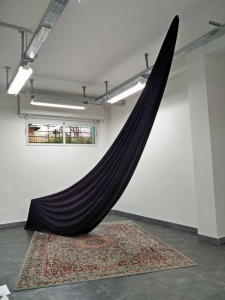 Iulia Gabriela Toma & Claudiu Cobilanschi: Buongiorno, Varvara Stepanova
Iulia Gabriela Toma & Claudiu Cobilanschi: Buongiorno, Varvara Stepanova
2 April 2016 – 10 June 2016
Gallleriapiù
via del Porto 48 a/b, Bologna
www.gallleriapiu.com
For the exhibition “Buongiorno, Varvara Stepanova” the Romanian artist-duo Iulia Gabriela Toma and Claudiu Cobilanschi focused on the Lithuanian-Russian artist Varvara Stepanova (1894-1958).
Stepanova was part of the Russian avant-garde before the revolution in 1917 and then associated to the constructivist movement. Her broadly based artistic activities contained painting, graphic art, stage scenery construction, and textile and clothing designs. The constructivist objective was to use art for architecture, design, typography, stage design and fashion and contribute with that to the development of the revolutionary society. After the division of the constructivist movement in 1920 Stepanova dedicated her work mostly to design of functional clothing. She differentiated three groups of dresses depending of the intended use: work, sports and leisure. Her unisex designs were inspired by geometric forms to abolish gender and class distinctions. Later she concentrated more on graphics. In cooperation with Alexander Rodchenko she designed posters, books and magazines. Their style of photomontages was characteristic for expressive political messages. Stepanova’s work was aimed to support to the future orientated socialistic society.
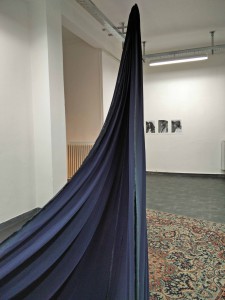 The exhibition at the Gallleriapiù consists of three site-specific works and two older creations. “Grey Flags” makes the prelude. It is an expansive installation that takes two thirds of the first room. A large dark blue cloth is attached to the ceiling. Its other ends are fixed half high at the wall, so that the textile falls in an enlarging crescent to the floor. At first view it could remind a tip of a Venetian gondola. Underlying is an oriental carpet. In the constructivist context it could refer to Vladimir Tatlin’s “Monument to the Third International” (1919–20), also known as Tatlin’s Tower. For Claudiu Cobilanschi the installation might illustrate the constructivist dream, since it is inspired by the “Monument to the Conquerors of Space” in Moscow, like he mentioned it on Facebook.
The exhibition at the Gallleriapiù consists of three site-specific works and two older creations. “Grey Flags” makes the prelude. It is an expansive installation that takes two thirds of the first room. A large dark blue cloth is attached to the ceiling. Its other ends are fixed half high at the wall, so that the textile falls in an enlarging crescent to the floor. At first view it could remind a tip of a Venetian gondola. Underlying is an oriental carpet. In the constructivist context it could refer to Vladimir Tatlin’s “Monument to the Third International” (1919–20), also known as Tatlin’s Tower. For Claudiu Cobilanschi the installation might illustrate the constructivist dream, since it is inspired by the “Monument to the Conquerors of Space” in Moscow, like he mentioned it on Facebook.
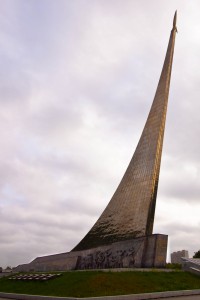 This memorial, designed by Andrei Petrovitsch Faidysh-Krandievski (1920–1967), should not be called constructivist, due to its realism. Whereas the underlying idea behind the work stands for the future orientated socialistic society. In 1958, a few months after the start of the Sputnik 1, the first artificial satellite in space, a competition was launched to create an obelisk, remembering the conquest of the cosmos. The sculptor Faidysh-Krandievski and the two architects Alexander Nikolajevitsch Kolschin and Michail Ossipovitsch Barshsch won with the 1964 realised proposal. The memorial consists of two parts: an obelisk, a starting ascending rocket with its flue gas and condensation trail and the Memorial Museum of Cosmonautics in its base. With this landmark the Soviet Union celebrated the efforts made by the Soviet people to conquer the space. It might stand for the attainment of the constructivist dream to make a better future by the revolution.
This memorial, designed by Andrei Petrovitsch Faidysh-Krandievski (1920–1967), should not be called constructivist, due to its realism. Whereas the underlying idea behind the work stands for the future orientated socialistic society. In 1958, a few months after the start of the Sputnik 1, the first artificial satellite in space, a competition was launched to create an obelisk, remembering the conquest of the cosmos. The sculptor Faidysh-Krandievski and the two architects Alexander Nikolajevitsch Kolschin and Michail Ossipovitsch Barshsch won with the 1964 realised proposal. The memorial consists of two parts: an obelisk, a starting ascending rocket with its flue gas and condensation trail and the Memorial Museum of Cosmonautics in its base. With this landmark the Soviet Union celebrated the efforts made by the Soviet people to conquer the space. It might stand for the attainment of the constructivist dream to make a better future by the revolution.
“Grey Flags” repeats obviously the form of the contrail with the blue cloth. Additionally, the rectangular carpet stands for the cube of the monument’s base. The chosen material is oriented to Stepanovas activities as designer of clothing. That citation of the monuments form could be the artists approach to questions like “What was Varvara Stepanova hoping while designing functional clothing? Where is the big change yearned for by Constructivism? Where does Tatlin’s tower bring us?”
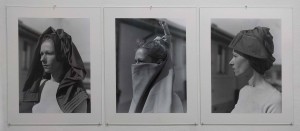 On the opposed wall in the same room, are three photos showing Iulia Gabriela Toma with sports garments: “Emotional armours” (2015). They are alienated as headdress. On one hand these photos are a reference that Stepanova done clothing designs and with that her categories. Moreover it is a personal allusion to Toma’s mother, who was an active sportswoman. At the same time the drapery corresponds to the fall of folds in “Grey flag”. The head covering at the middle photo reminds supplementary the form of the installation.
On the opposed wall in the same room, are three photos showing Iulia Gabriela Toma with sports garments: “Emotional armours” (2015). They are alienated as headdress. On one hand these photos are a reference that Stepanova done clothing designs and with that her categories. Moreover it is a personal allusion to Toma’s mother, who was an active sportswoman. At the same time the drapery corresponds to the fall of folds in “Grey flag”. The head covering at the middle photo reminds supplementary the form of the installation.
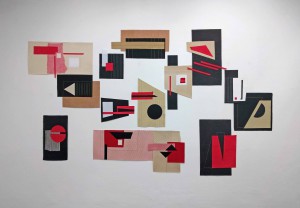 With “Rhythmical Logic” and a series of charcoal drawings there is another approach to Stepanova’s work in the second room. “Rhythmical Logic” is an oeuvre of fourteen cloth collages. Dominated by the colours black, red and beige with the white wall background, the chosen material is once again a reference to the artists work. At the same time it is formally inspirited by constructivist paintings by the choice of geometric figures. The same is valuable for the seven charcoal drawings, since they are reminding cutting patterns. Besides, some could represent as well architectural drafts, x-rays or studies on composition. In their reduced formal language and the absence of a real figurative equivalent they are connected to the constructivism.
With “Rhythmical Logic” and a series of charcoal drawings there is another approach to Stepanova’s work in the second room. “Rhythmical Logic” is an oeuvre of fourteen cloth collages. Dominated by the colours black, red and beige with the white wall background, the chosen material is once again a reference to the artists work. At the same time it is formally inspirited by constructivist paintings by the choice of geometric figures. The same is valuable for the seven charcoal drawings, since they are reminding cutting patterns. Besides, some could represent as well architectural drafts, x-rays or studies on composition. In their reduced formal language and the absence of a real figurative equivalent they are connected to the constructivism.
In the last room is the video “Hello Worlds” (2015) by Claudiu Cobilanschi is projected. It shows the effort of a man to communicate with someone somewhere above in the sky. He is standing in a solitary landscape and seems to give signs with a large cloth. Once he is spreading it on the floor, another time he holds it high above his head, so that it is waving like a flag in the wind. The film gives no hint, if someone might observe the scenery from above. Within the exhibition the video corresponds to “Grey Flags”. Sometimes the blanket reminds the blue textile piece. Moreover it leads the mind to the sky where the Sputnik 1 might be.




